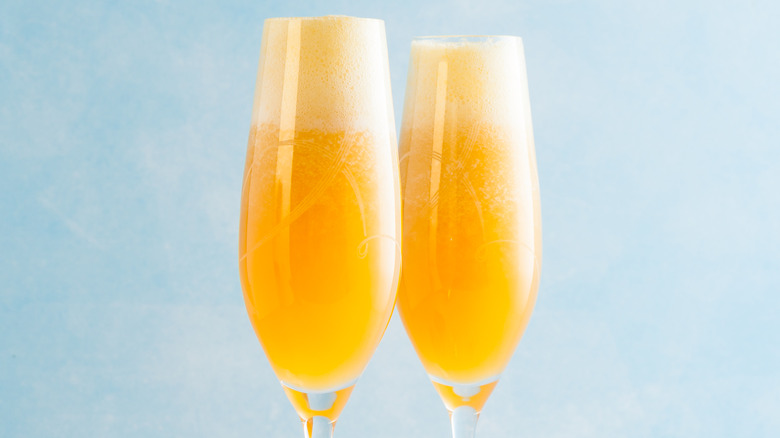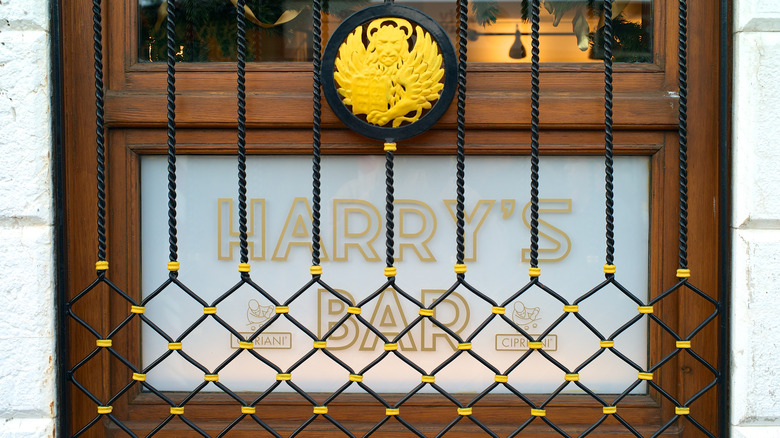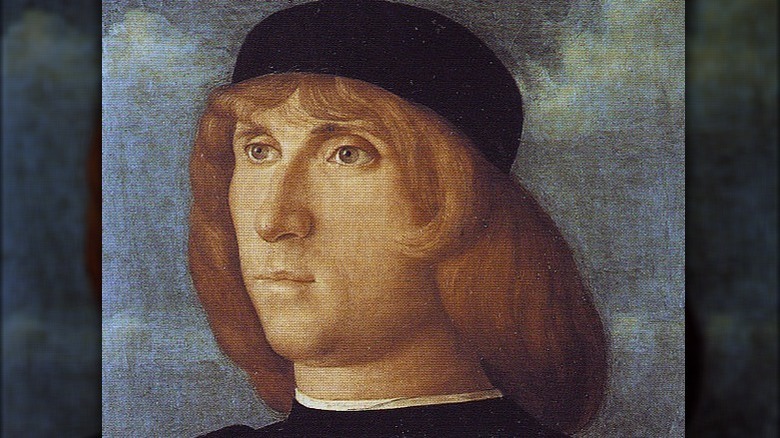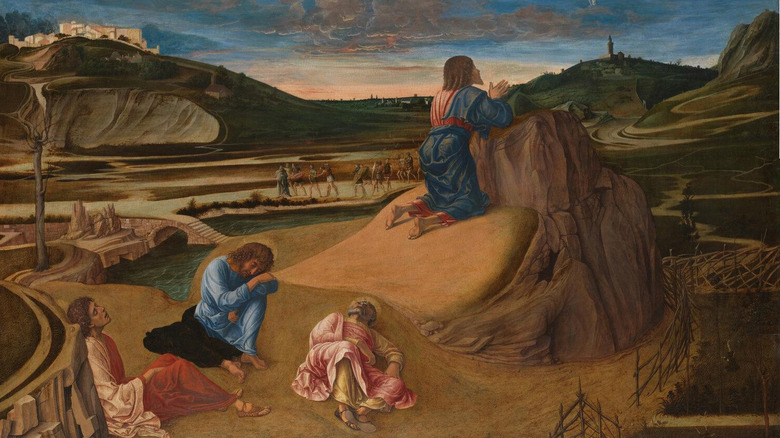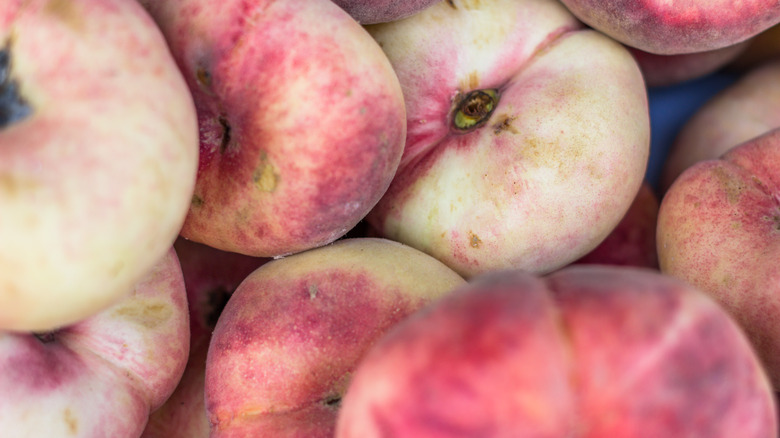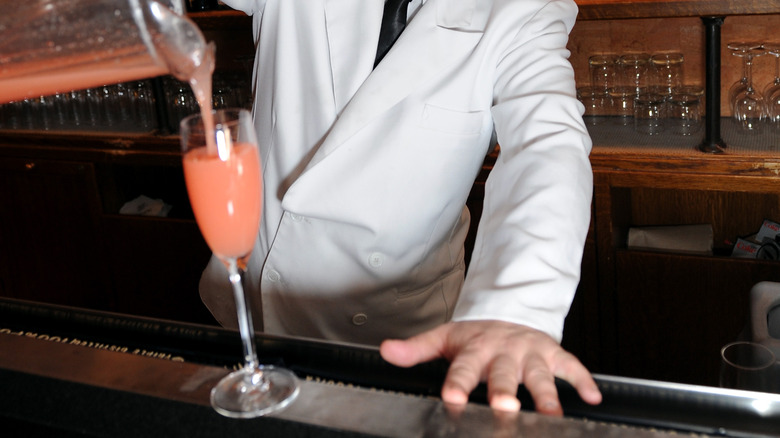The History Of How Giovanni Bellini May Have Inspired A Classic Cocktail
It's a rare cocktail that's best known for being consumed at breakfast or brunch — options include the mimosa, the Bloody Mary, and perhaps the most delicious option of all, the Bellini. A deceptively simple drink, the Bellini traditionally calls for just two ingredients: peach puree and Prosecco, which (per Vinepair) is a sparkling wine that is only made from the white Glera grape, and only from the northern regions of Veneto and Friuli in Italy. It's often compared to the generally more expensive and popular sparkling wine Champagne, but the two beverages have fewer similarities than it might appear at first glance and sip.
Not only are they made from different grapes and originate in different countries (Prosecco is Italian, Champagne is French), but they get their bubbles from entirely different methods. Champagne gets bubbly via the Méthode Champenoise during its second fermentation. This happens inside the bottle, which makes it taste more complex and less fruit-forward. Prosecco is carbonated during its second fermentation via the Charmat method, which employs large, stainless steel tanks before bottling. The result is a younger, fruitier body and flavor.
The home of the Bellini is a legendary cafe
The Bellini cocktail was invented by Guiseppe Cipriani at his original Harry's Bar in Venice, Italy. As reported by ABC Fine Wines & Spirits, Cipriani founded the iconic watering hole in 1931 and it became known as a popular hangout spot for writers and artists. Sinclair Lewis, Orson Welles, Alfred Hitchcock, Humphrey Bogart, Katharine Hepburn, and perhaps most famously Ernest Hemingway were all known as habitual Harry's patrons. Hemingway reportedly wrote much of his novel "Across The River And Into The Trees" while sitting at Harry's Bar, and it's used as a setting throughout the story.
The Cipriani website attributes its immediate early success to "service, freedom and lack of imposition" and ascribes the ongoing popularity of Harry's Bar to its atmosphere, warmth, easy conversation among friendly clientele, and "somewhat knowing" staff, giving it a "club-like feeling that all the best European cafes possess." In 2001, the Italian Ministry of Cultural Heritage declared it a National Landmark.
The original Bellini was a Venetian painter
Rumors spread in May 2020 that Harry's Bar would be closing permanently after current owner (and son of Guiseppe) Arrigo Cipriani complained about the regulations surrounding reopening after being closed for two months during the original COVID-19 outbreak. Per Town & Country, the closure was temporary and it has since reopened, meaning people can go and have a Bellini at the very place the first one was ever mixed up and served.
So why is it that the Bellini is called the Bellini? In his 1996 book "Harry's Bar: The Life and Times of the Legendary Venice Landmark," Arrigo Cipriani explained that his father had been a huge fan of the 15th century Venetian painter Giovanni Bellini (above, in a self-portrait). Per the younger Cipriani, "I had no idea at the time that the pink glow my father so admired in one of Bellini's paintings would be the inspiration for his famous cocktail."
That iconic pink glow
It's unclear which particular Giovanni Bellini painting inspired Guiseppe Cipriani to name the Bellini cocktail, as descibed by Arrigo Cipriani in "Harry's Bar: The Life and Times of the Legendary Venice Landmark," because that pink cast is a common feature in a few of Bellini's works. One likely candidate is "Agony In The Garden" (above), an early Bellini painting thought to have been painted between 1458 and 1460 and purchased in 1863 by The National Gallery in London, England. The National Gallery notes that "Christ's pink tunic blends with the peach light of the dawn sky, which highlights the undersides of the plump clouds. This soft, warm light gilds the entire scene."
Arrigo Cipriani went on to describe his father's love for the white peaches that were available throughout Italy between June and September. The elder Cipriani wanted to make a cocktail that highlighted the peaches' wonderful smell and after some experimentation, developed the recipe of pureeing the peaches and adding Prosecco. It premiered at Harry's Bar in 1948 to rave reviews from the patrons, and history was made.
Bellini controversy in the 1990s
Per Arrigo Cipriani in his book "Harry's Bar: The Life and Times of the Legendary Venice Landmark," the Bellini cocktail became so popular that they employed staff whose sole task was to create the peach puree by squeezing and pitting the fruit with their bare hands. The drink was only available during the summer peach season until someone invented a method of fresh-freezing the puree and became the supplier to all Harry's Bar locations, including the original in Venice.
In 1990, Cipriani licensed the Bellini to Luciano Canella, who set out to make a bottled version of the cocktail. Cipriani was unhappy with the result, which he described as "a 'ready mix' containing the puree and the prosecco. And to accentuate the pink, he used a drop of raspberry juice. The drink was awful." Cipriani and Canella ended up in arbitration; Cipriani wrote, "I won and the whole affair was promptly forgotten." Canella still makes their bottled version of the Bellini cocktail, but it's no longer affiliated with the Cipriani family or Harry's Bar. In fact, Cipriani Drinks sells its own bottled Bellini, which it claims uses the original recipe from 1948.
Make your own Bellini ... carefully
For purists, Cipriani Drinks gives detailed instructions on their website as to how to make a fresh Bellini like the one you might order at Harry's Bar. Per Arrigo Cipriani, it's important to only use white peaches, never yellow, and "better still if the white peaches are small with a pink skin." The necessary peaches are no longer solely available in Venice, Italy and may now be found in many different places with the requisite mild, temperate climate.
To prepare the peach puree, Cipriani Drinks instructs at-home mixologists to rinse the peaches and mash them, skin and all, using a potato masher or fork. The use of a blender is strictly cautioned against, as this will mix air into the juice. Pour the puree into a glass and add Prosecco on top, keeping a one-to-three ratio, e.g. two ounces of puree topped with six ounces of Prosecco. Gently stir and serve.
According to Italy Heritage, other cocktails that use this popular fruit and Prosecco combination include the mimosa, which replaces peach puree with orange juice, the Rossini, made with strawberries, and the Tintoretto, which uses pomegranate.
